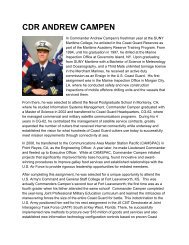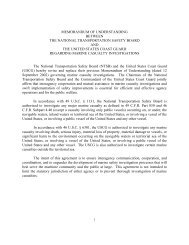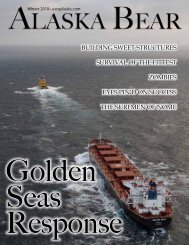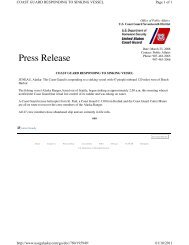marine board report - Off Soundings
marine board report - Off Soundings
marine board report - Off Soundings
Create successful ePaper yourself
Turn your PDF publications into a flip-book with our unique Google optimized e-Paper software.
Commandant<br />
United States Coast Guard<br />
2100 Second Street, S.W.<br />
Washington, DC 20593-0001<br />
Staff Symbol: G-MOA<br />
Phone: (202) 267-1430<br />
Fax: (202) 267-1416<br />
19 December 2003<br />
16732<br />
SINKING OF THE UNINSPECTED FISHING VESSEL ARCTIC ROSE, OFFICIAL<br />
NUMBER 931446, IN THE BERING SEA ON APRIL 2, 2001, WITH ONE PERSON<br />
DECEASED AND FOURTEEN PERSONS MISSING AND PRESUMED DEAD<br />
ACTION BY THE COMMANDANT<br />
The record and the <strong>report</strong> of the Marine Board of Investigation convened to investigate the<br />
subject casualty have been reviewed. The record and the <strong>report</strong>, including the findings of fact,<br />
analysis, conclusions, and recommendations are approved subject to the following comments.<br />
COMMENTS ON FINDINGS OF FACT<br />
Finding of Fact 7.d, paragraph 1: At 0335, on April 2, 2001, the command center in D17 Juneau<br />
received a 406 MHz EPIRB notification over telex. The message identified the EPIRB as<br />
registered to the ARCTIC ROSE. The watch supervisor telephoned the company’s Seattle,<br />
Washington representative provided by the EPIRB signal, Mr. David Olney, and requested he<br />
contact the ARCTIC ROSE to determine if the alert was a false alarm. Mr. Olney called back to<br />
inform the CC that he was unable to reach the vessel by phone or email. The CC issued an<br />
Urgent Marine Information Broadcast (UMIB) alerting all vessels to be on the lookout for the<br />
ARCTIC ROSE and/or survivors. Mr. Olney contacted the CC and passed that his company’s<br />
other vessel, the ALASKAN ROSE was in the area fishing with the ARCTIC ROSE. COMSTA<br />
Kodiak attempted to contact the ALASKAN ROSE without success. At approximately 0400,<br />
AIRSTA Kodiak launched a C-130 to begin searching for the ARCTIC ROSE. The C-130 and<br />
COMSTA attempted to hail the ARCTIC ROSE without success. At approximately 0730,<br />
shortly before the C-130’s arrival on-scene, contact was made with the ALASKAN ROSE via<br />
VHF radio. Mr. John Nelson, who was on watch, informed the C-130 crew that he did not hear<br />
of a Mayday or call for assistance from the ARCTIC ROSE and immediately altered the vessel’s<br />
course to intercept the EPIRB. The mate awoke Captain Anderson and briefed him on the<br />
situation. Mr. Nelson tried numerous times to hail the ARCTIC ROSE on VHF radio without<br />
success. The ALASKAN ROSE was eleven miles due south of the EPIRB position. It took<br />
approximately one hour for the ALASKAN ROSE to arrive on-scene.<br />
Comment: In addition to the UMIB issued by the Coast Guard Seventeenth District’s Command<br />
Center (D17CC) and the attempts to contact the ALASKAN ROSE by Communications Station<br />
(COMSTA) Kodiak and the C-130 aircraft, there were also seven individual INMARSAT C<br />
messages sent from the D17CC in Juneau, AK, to the ALASKAN ROSE beginning at 0413.<br />
Two were sent over a prototype system operated by COMSAT (now TELNOR), and five were<br />
sent over a server, which is no longer in service. The prototype COMSAT system was incapable<br />
of initiating a distress-priority message, and the server, while capable of initiating a distresspriority<br />
message, did not do so for reasons unknown.












